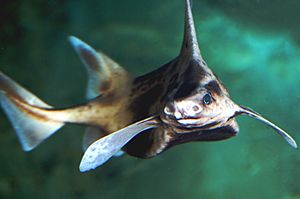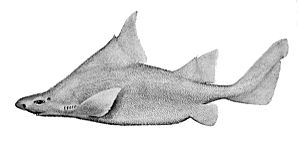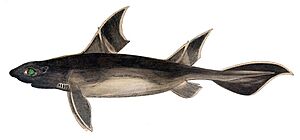Oxynotus facts for kids
Quick facts for kids Oxynotus |
|
|---|---|
 |
|
| Caribbean roughshark, Oxynotus caribbaeus | |
| Scientific classification |
|
| Kingdom: | Animalia |
| Phylum: | Chordata |
| Class: | Chondrichthyes |
| Order: | Squaliformes |
| Family: | Oxynotidae T. N. Gill, 1912 |
| Genus: | Oxynotus Rafinesque, 1810 |
| Type species | |
| Oxynotus centrina Rafinesque, 1810
|
|


Imagine a shark that looks a bit like a triangle! That's a rough shark, part of a group called Oxynotus. These unique sharks are the only living members of their family, the Oxynotidae. You can find them swimming deep down in the Atlantic Ocean and the western Pacific Ocean.
Rough sharks are not huge; they usually grow to be about 49 to 150 centimeters long (that's about 1.5 to 5 feet). Their bodies are quite flat on the sides, which makes them look almost triangular when you see them from the front. They have two big fins on their backs, called dorsal fins, and each one has a sharp spine! The first dorsal fin is placed very far forward, almost above their head. Their skin is super rough and prickly, even more so than other sharks like dogfish. And here's a cool fact: they can actually glow in the dark! They have a special organ that produces light, a process called bioluminescence.
Discovering Rough Sharks
Rough sharks are fascinating creatures of the deep sea. They belong to a larger group of sharks called Squaliformes, which includes many types of dogfish sharks. What makes rough sharks special is their unusual body shape and their ability to create their own light. They prefer to live in the mysterious deep waters, far from the sunny surface.
Different Kinds of Rough Sharks
There are several known species of rough sharks, each with its own unique features. Here are some of the rough shark species that scientists have identified:
- Prickly dogfish (Oxynotus bruniensis)
- Caribbean roughshark (Oxynotus caribbaeus)
- Angular roughshark (Oxynotus centrina)
- Japanese roughshark (Oxynotus japonicus)
- Sailfin roughshark (Oxynotus paradoxus)
- There was also an extinct species called Oxynotus crochardi, which is no longer found today.

